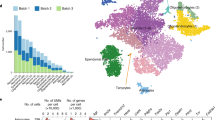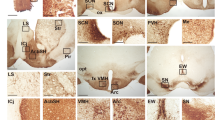Abstract
Spontaneous discharges of individual neurons in the suprachiasmatic nucleus (SCN) of Clock mutant mice were recorded for over 5 days in organotypic slice cultures and dispersed cell cultures using a multi-electrode dish. Circadian rhythms with periods of about 27 hours were detected in 77% of slice cultures and 15% of dispersed cell cultures derived from Clock/Clock homozygotes. These findings indicate that the Clock mutation lengthens the circadian period but does not abolish the circadian oscillation, and suggest an important role of intercellular communication in the expression of circadian rhythm in the SCN.
This is a preview of subscription content, access via your institution
Access options
Subscribe to this journal
Receive 12 print issues and online access
$209.00 per year
only $17.42 per issue
Buy this article
- Purchase on Springer Link
- Instant access to full article PDF
Prices may be subject to local taxes which are calculated during checkout



Similar content being viewed by others
References
Klein, D. C., Moore, R. Y. & Reppert, S. M. The Suprachiasmatic Nucleus: The Mind's Clock (New York, Oxford Univ. Press, 1991).
Welsh, D. K., Logothetis, D. E., Meister, M. & Reppert, S. M. Neuron 14, 697–706 (1995).
Honma, S., Shirakawa, T., Katsuno, Y., Namihira, M. & Honma, K. Neurosci. Lett. 250, 157–160 (1998).
King, D. P. et al. Cell 89, 641–653 (1997).
Antoch, M. P. et al. Cell 89, 655–667 (1997).
Vitaterna, M. H. et al. Science 264, 719–725 (1994).
King, D. P. & Takahashi, J. S. Annu. Rev. Neurosci. 23, 713–742 (2000).
Low-Zeddies, S. S. & Takahashi, J. S. Cell 105, 25–42 (2001).
Herzog, E. D., Takahashi, J. S. & Block, G. D. Nat. Neurosci. 1, 708–713 (1998).
Balsalobre, A., Damiola, F. & Schibler, U. Cell 93, 929–937 (1998).
Acknowledgements
We thank J. S. Takahashi and N. Ishida for generous gifts of Clock mutant mice, and T. Yasuda for technical assistance. This work was supported in part by a Grant-in-Aid for scientific research from the Ministry of Education, Science, Culture, Sports and Technology of Japan (nos. 11233201 and 12557005).
Author information
Authors and Affiliations
Corresponding author
Ethics declarations
Competing interests
The authors declare no competing financial interests.
Supplementary information
Supplementary Fig. 1.
Representative wheel-running activities of Clock mutant and wild-type mice. Wheel-running activities were measured under DD after recording under light/dark (LD) cycle for 10 d. White and black bars indicated times of lights-on and lights-off, respectively. Detection of a circadian rhythm and calculation of a period were done by a χ-square periodogram using a record of every 10 d under DD. The circadian periods of these mice in the first, second and third 10-d periods mice were 24.1, 24.5 and 24.9 h for Clock/+ and 23.5, 23.6 and 23.5 h for +/+, respectively. Clock/Clock showed significant circadian rhythm with a period of 28.0 h in the first 10 d under DD and then became arrhythmic. (GIF 38 kb)
Supplementary Fig. 2.
A phase-contrast photomicrograph of a cultured SCN slice on a multi-electrode dish after 14 d in culture. A pair of the SCN was recognized as densely packed neuronal areas located immediately above the degenerated optic chiasm together with electrodes. The black squares indicated the 64 electrodes with a size of 20 µm square arranged in an 8 × 8 pattern with 100 µm separation. V, third ventricle; OC, optic chiasm; SCN, suprachiasmatic nucleus. Scale bar, 150 µm (GIF 184 kb)
Rights and permissions
About this article
Cite this article
Nakamura, W., Honma, S., Shirakawa, T. et al. Clock mutation lengthens the circadian period without damping rhythms in individual SCN neurons. Nat Neurosci 5, 399–400 (2002). https://doi.org/10.1038/nn843
Received:
Accepted:
Published:
Issue Date:
DOI: https://doi.org/10.1038/nn843
This article is cited by
-
GABA in the suprachiasmatic nucleus refines circadian output rhythms in mice
Communications Biology (2019)
-
Non-coding cis-element of Period2 is essential for maintaining organismal circadian behaviour and body temperature rhythmicity
Nature Communications (2019)
-
CLOCKΔ19 mutation modifies the manner of synchrony among oscillation neurons in the suprachiasmatic nucleus
Scientific Reports (2018)
-
The mammalian circadian system: a hierarchical multi-oscillator structure for generating circadian rhythm
The Journal of Physiological Sciences (2018)
-
Role of GABA in the regulation of the central circadian clock of the suprachiasmatic nucleus
The Journal of Physiological Sciences (2018)



